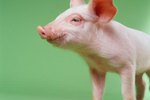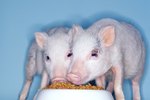
Show pigs are the beauty contestants of the hog world. They're judged not only on appearance, but on how they might improve breed genetics. Ideally, show pigs are both heavily muscled and lean. They have that "eye appeal" of the correctly proportioned animal, but also meet all standards required by commercial hog producers.
Selection
When selecting a potential show pig, look carefully at conformation. Utah State University Extension advises choosing a well-muscled, large-boned hog. A pig with good bone structure, or structural correctness, moves well. That's important, because pigs with soundness issues don't place well at shows. The chest should be wide, and the animal should possess a strong rib cage. The pig must appear healthy, with no obvious problems. It should be the correct size for its current age, neither over- nor undersized.
Meet the Parents
If you're buying a pig from a private farm, ask to see the boar and sow. That helps give you an idea of how your pig will develop. You should also ask to see any full or half siblings from previous matings, if that's possible. You should investigate the genetic lines of any pig you're considering. The breeder should be able to supply you with the information.
Timing
Since pigs are generally shown between the ages of 6 and 7 months, choose a piglet that will be that age at the time of your major show. You must also know what the pig is expected to weigh at the time of the show. Older pigs might exceed the maximum weight allowed for classes. Underfeeding a pig that is outgrowing the weight limit is not only bad husbandry, but the pig also won't show well against correctly aged and sized hogs.
Breeds
If your primary shows consists of breed classes, you must choose a purebred animal. If the show doesn't contain breed classes, you have a wider choice. Louisiana State University Extension recommends choosing purebred Durocs, Hampshires or Yorkshires, or crosses of those breeds for non-purebreds. According to LSU Extension, these breeds and crosses often exhibit more show qualities than other pigs.
Husbandry
Once you've chosen your pig, it's up to you to ensure that your animal receives the best care so it can make the best impression on show day. Keep your pig in a clean, dry pen, with water always available. Feed a quality pig chow. Weigh your pig regularly, keeping a record of how much food he's consuming daily. Ask your vet about a deworming protocol for your animal. The pig also needs sufficient exercise so he doesn't develop excess fat. Walk him about 150 yards daily, which also helps you practice for showing.
References
Photo Credits
-
Digital Vision./Digital Vision/Getty Images
Writer Bio
Jane Meggitt has been a writer for more than 20 years. In addition to reporting for a major newspaper chain, she has been published in "Horse News," "Suburban Classic," "Hoof Beats," "Equine Journal" and other publications. She has a Bachelor of Arts in English from New York University and an Associate of Arts from the American Academy of Dramatics Arts, New York City.




